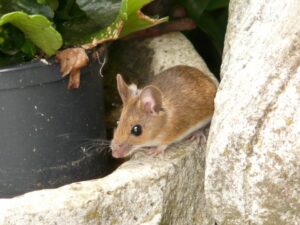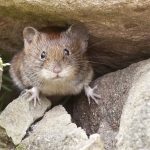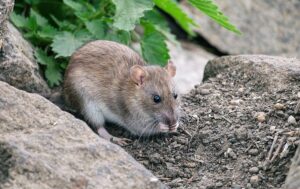Cleaning Up After Rodents
Urine and Droppings
Take precautions before and during clean up of rodent-infested areas. Before cleaning, trap the rodents and seal up any entryways to ensure that no rodents can get in. Continue trapping for a week. If no rodents are captured, the active infestation has been eliminated and enough time has passed so that any infectious virus in the rodent’s urine/droppings or nesting material is no longer infectious.
Before starting clean up of the space, ventilate the space by opening the doors and windows for at least 30 minutes to allow fresh air to enter the area. Use cross-ventilation and leave the area during the airing-out period.
First, clean up any urine and droppings
When you begin cleaning, it is important that you do not stir up dust by sweeping or vacuuming up droppings, urine, or nesting materials.
Wear rubber, latex, or vinyl gloves when cleaning urine and droppings.
Spray the urine and droppings with a disinfectant or a mixture of bleach and water and let soak 5 minutes. The recommended concentration of bleach solution is 1 part bleach to 10 parts water. When using a commercial disinfectant, following the manufacturer’s instructions on the label for dilution and disinfection time.
Use a paper towel to pick up the urine and droppings, and dispose of the waste in the garbage.
After the rodent droppings and urine have been removed, disinfect items that might have been contaminated by rodents or their urine and droppings.
Next, clean and disinfect the whole area
Mop floors and clean countertops with disinfectant or bleach solution.
Steam clean or shampoo upholstered furniture and carpets with evidence of rodent exposure.
Wash any bedding and clothing with laundry detergent in hot water if exposed to rodent urine or droppings.

Rats and mice
offers advice on how to control rat or mouse problems on private property. Control methods including poison baits and traps can stop mouse infestations. Follow Council’s tips on rodent proofing your house. Make sure they aren’t attracted to your property by a food supply. You can also report a rodent problem on a neighbouring property.
Rodents in your home or garden
The two types of pest rats most commonly found in Brisbane are:
large brown sewer rat (Rattus norvegicus)
grey or black climbing rat (Rattus rattus).
The sewer rat nests and burrows under buildings. They generally live in areas near commercial farms, rather than suburban areas. Climbing rats generally nest in homes.
Report a rat or mouse problem
Before reporting a rodent sighting to Council, check the Controlling rats guide to see if the animal you have seen is a native mammal or a rat. If you believe a property is harbouring rats or mice
Poison baits and traps
The two main ways of getting rid of rats or mice are poison baits and traps. You can purchase baits and traps from a hardware store. Place the baits or traps in areas where you’ve seen rodents. To bait a trap, use a piece of apple, a pumpkin seed or a piece of fat from some meat. Tie the bait on with a piece of wire. This will make it hard for a rodent to remove meat without setting the trap off.
Make sure you follow the safety instructions on the packet. Ensure you store baits and traps out of reach of children or pets. You can also purchase lockable stations and humane traps from some retail outlets. These traps are safer for children and pets than poison baits.

HOW TO GET RID OF RODENT PESTS IN THE HOME
I’ve lived in a well-built old house sheathed with cedar shingles for decades, throughout which I’ve often (but never intentionally) shared it with mice, flying squirrels, sometimes chipmunks, and, occasionally, Norway rats. What to do? Here’s advice for identifying, controlling, and preventing in the home.
HOW DO RODENTS GET IN?
Rodents are able to come in through impossibly tiny openings: a rat or flying squirrel can squeeze through an opening the size of a quarter; a mouse, the size of a dime. They come in through soffits, vents, and openings in chimney flashing.
The word rodent derives from the Latin root rodere, which means “to gnaw,” and gnaw they do. Their upper and lower incisors grow continuously throughout their lives, which requires constant gnawing. They will chew their way through wood, cinderblock, brick, mortar, and even aluminum, not to mention all manner of plastics.
WHY DO RODENTS INVADE THE HOME?
Rodents enter homes for the same reasons people live in them: to meet their needs for shelter, water, food, and protection (in their case, from predators such as foxes, coyotes, cats and dogs, weasels, hawks, and owls).
SIGNS OF A RODENT PROBLEM
If you have rodent guests in your home, you might:
Find a stash of dog kibble or sunflower seeds tucked in behind the socks in your underwear drawer.
Discover that the plastic has been chewed off electrical cords or wires.
Encounter evidence of nesting materials: chewed-up toilet paper, newspaper, wrapping paper, old term papers tucked away in a paper box in the attic.
Find chew marks, shreds of chewed materials, holes chewed or partially chewed through sills, in the corners of doors or cupboards, in mattresses, couch cushions, rag piles.
See droppings, especially in areas where rodents have come into your living space to feast on left-out food and crumbs: Mouse droppings are the size and shape of a grain of rice; rat and squirrel droppings are sausage-shaped and up to ¾-inch long. (Note: A rodent will pass 50-75 fecal pellets a day. It’s rare to host a single rodent.)
Hear scratching, chewing, squealing, or rustling sounds inside the walls.
Hear them shrieking, squealing, and chasing each other through your walls after dark.
Find your cat or dog meowing, whining, or sitting for hours staring at a patch in the wall if they hear or sniff rodents inside.
Detect a rank, musky odor in areas where rodent droppings and urine have built up.

Get Rid Of Mice
Keep Mice & Their Diseases Out
We all tend to spend more time indoors when the weather turns cold. With an average winter temperature of -16.6 degrees Celsius, Red Deer certainly qualifies as cold during the winter months.
These extremely low temperatures cause many animals that spend their summers in the fields to seek warmth, often in our homes, businesses, and barns. The most prevalent of these is mice. Generally viewed as a relatively innocuous nuisance creature, mice are messy and multiply very quickly, which makes it hard to get rid of an infestation once it takes hold. The most effective means of dealing with mice is perimeter protection in the form of mechanical traps and poisons
The health risks that are associated with mouse infestations weren’t fully known until relatively recently. The mice themselves carry a variety of bacterial and viral threats, which can be passed to humans directly, through contact with contaminated surfaces and foodstuffs, and even through mites and fleas that the mice bring with them.
had one confirmed case of Hantavirus, a potentially dangerous viral infection known to be carried by Deer mice. Hantavirus can cause a fatal lung condition to develop in its victims. Other diseases that can be transmitted by the common House mouse and associated parasites are leptospirosis (a potentially fatal bacterial infection caused by contact with the infected rodent’s urine), rickettsialpox (a bacterial illness transmitted between mice and humans by mites), tularemia (a serious bacterial illness transmitted directly from mice, through contaminated water, and by tick bites), and lymphocytic choriomeningitis, a viral disease that can cause meningitis and encephalitis in its human victims. Rodents are infamous for their role in carrying the “Black Death”, or bubonic plague that swept through Europe in the 14th Century, killing nearly half the population.
While all this talk of disease may seem rather alarmist, we’re not out to scare you. We just want to illustrate that a rodent problem can be serious and should be dealt with right away, as they can become much worse very quickly.
Rodent Identification
What are rodents?
Rodents make up the single largest group of mammals, with about 1,500 different species living worldwide. Each species has unique habitats, food preferences, and appearance. All rodents, no matter their species, have continuously growing front incisors. To prevent their teeth from overgrowing, they constantly gnaw on objects – causing damage to those objects in the process.
Two of the most common rodent species living in our area are the mouse and rat. An adult mouse is much smaller than an adult rat. Both have bodies covered in black or brown hair with a lighter colored underbelly. Other physical differences between the two rodents are their snouts; mice have pointed noses, while rats tend to have blunt noses. Also, compared to the size of their heads, mice have large ears, while rats have small ears. Another difference between them is that the long scaly tail of a mouse is covered in a light layer of velvety hair, while the long scaly tail of a rat is void of hair.
Are rodents dangerous?
Rodents are dangerous pests that can spread pathogens that make people ill. Mice and rats are capable of spreading more than 35 diseases through their saliva, excrement, and urine. Other problems associated with a rodent infestation include:
Allergies. Many people are allergic to rodent excrement and their shed fur.
Parasites. Rodents harbor disease-carrying parasites like fleas, ticks, and mites that they introduce onto properties and eventually into homes.
Damage. Their chewing habits cause damage to structural beams, wires, pipes, insulation, flooring, furniture, books, pictures, and more.
Why do I have a rodent problem?
You’ll always find rodents living close to us. They may be shy by nature but are not shy about using our yards and homes for shelter, our gardens or trash cans to forage for food, and our leaky outdoor fixtures for water. Rodents are prolific breeders and can to take over any property they invade quickly.
Where will I find rodents?
Rodents like to live outside in a variety of places, including wooded areas, fields, tall grasses, woodpiles, and gardens. They often nest in dense vegetation near foundations or under foundations. Rats, depending on their species, may also nest up off of the ground in trees. Mice only need a gap the size of a pencil, and rats the size of a quarter to get into a home or other building. Since these furry creatures often nest near the outside of buildings, they often find their way inside while foraging for food and water. Inside, rodents nest behind wall voids, attics, in rafters, and basements. They also like to take up residence behind large appliances and in upper and lower cabinets.